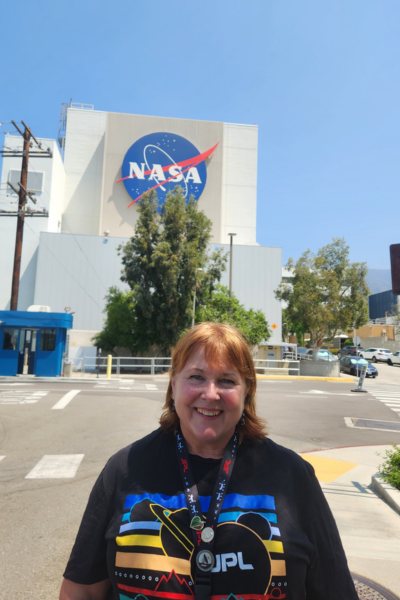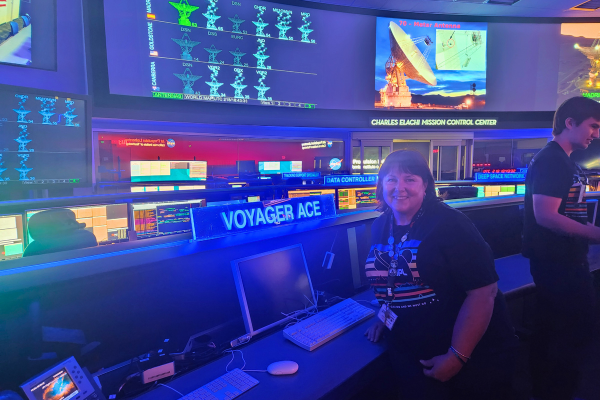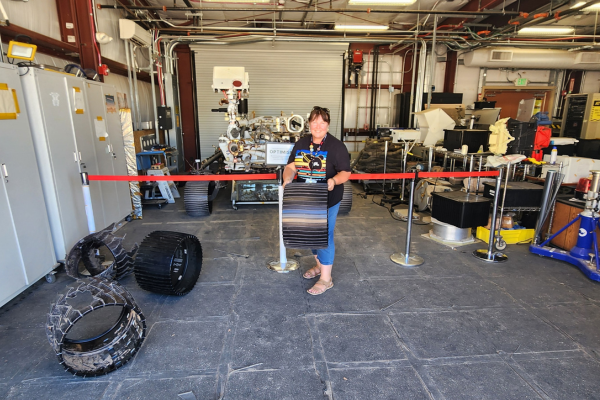SmartSat PhD candidate Donna Fitzgerald was recently selected for a prestigious ten-week internship at the NASA Jet Propulsion Laboratory (JPL) in California, USA. Now at the conclusion of her placement, Donna has penned the below update reflecting on her time working alongside leading scientists in Earth observation and adapting her research in a new and challenging environment.
I would like to start by sharing my deepest appreciation for being awarded the NASA Jet Propulsion Laboratory Internship, to extend my learning in Earth Observation and to work with experts in the field. I never thought that this could be a possibility, being an Environmental Scientist rather than an engineer or astro physicist. I was a bit worried as to how I would fit in with JPL and whether I would be able to enjoy the whole experience without a large amount of prior knowledge of the space industry…what a misconception!
 Donna, wearing her special issue Intern shirt in front of NASA’s Jet Propulsion Laboratory (JPL) in Pasadena, California.
Donna, wearing her special issue Intern shirt in front of NASA’s Jet Propulsion Laboratory (JPL) in Pasadena, California.
On my first day, I was given a brief tour of the lab and I almost had to keep pinching myself to ensure that I knew I was really at NASA JPL. Hearing about the history of JPL and the missions that were occurring only inspired me to want to learn more. The next day when I met my mentor, Dr Dave Schimel, I was made to feel very at ease. Dave said he just wanted me to enjoy the experience and to take advantage of any opportunities that arose.
Initially, I was going to work on EMIT hyperspectral satellite imagery. NASA’s EMIT (Earth Surface Mineral Dust Source Investigation) Mission uses a hyperspectral imaging spectrometer onboard the International Space Station to measure the different wavelengths of light emitted by minerals on the surface of deserts and other dust sources to determine their composition. This, I thought, would be a good fit for me as I worked with aerial hyperspectral imagery in my PhD.
However, the ENVI Remote Sensing Software I had previously used for processing and analysing hyperspectral imagery was not accessible at JPL, and to continue down the same path I would need to learn how to use Python scripting. I was faced with the decision to use the whole internship learning to use Python, or to perhaps start a different project. I was fortunate to be introduced to Dr Kerry Cawse-Nicholson, who is the lead scientist for the ECOSTRESS satellite, which produces thermal imagery across the globe and can be used to monitor vegetation health changes over time, in response to environmental stressors such as fire and drought. We both felt that utilising this data could be a good fit for my interest in eucalypt health changes relating to climate stress over time.
 Donna in the Charles Elachi Mission Control Center at NASA JPL (also known as the centre of the universe) where all the data from the Deep Space Network comes through.
Donna in the Charles Elachi Mission Control Center at NASA JPL (also known as the centre of the universe) where all the data from the Deep Space Network comes through.
I did some preliminary work on Spring Gully Conservation Park (an area I had worked on previously) with some good results. I then decided to focus on another area of interest in South Australia, which includes Scott Creek Conservation Park and has fire history in January 2021. The ECOSTRESS imagery is available from 2019 to present, so I decided to use the produced ESI (Evaporative Stress Index), which looks at how stressed the plants are under varying levels of stress, from very high stress to little or no stress. I also looked at the WUE (Water Use Efficiency), which showed how efficient or inefficient the plants are to the availability of water in their habitat.
At the end of my internship, I shared my work and results with Kerry. We are both very excited by what I have found, and I would definitely like to include these findings as a chapter in my final PhD Thesis. There is also the potential for my work to be published in a paper in collaboration with JPL! This is an absolute thrill, and I am looking forward to sharing my work with my university supervisors upon my return.
 The full-scale twin engineering model of NASA’s Perseverance Mars Rover, the OPTIMISM rover, located within NASA JPL’s Mars Yard.
The full-scale twin engineering model of NASA’s Perseverance Mars Rover, the OPTIMISM rover, located within NASA JPL’s Mars Yard.
 Donna standing in front of the OPTIMISM Rover, holding one of its wheels.
Donna standing in front of the OPTIMISM Rover, holding one of its wheels.
Throughout my internship, I have been exposed to many other aspects in space and Planetary Sciences through the lecturing series and various tours throughout JPL. I am now officially a space nerd! Most recently, I finally got to meet the ‘twin’ or engineering model of the Perseverance Mars Rover in the Mars Yard, where they simulate the Mars environment to test how the rover will adapt to different scenarios. I was so excited, even though it meant a walk up the very steep hill in 33-degree heat! I was also able to chat with one of the engineers and have my photo taken, which was a very cool experience.
Here at JPL, people have been very willing to share their research and work expertise across all areas. Being awarded this internship has validated my research as an important area to be working on through my PhD. I have taken advantage of every opportunity that has come my way here, both at work (JPL) and through simply living in another country for the past three months, and I have many stories to share when I get back to Australia. I am extremely grateful to have this support as it has allowed me to “Dare Mighty Things” – as they say at JPL!
Donna Fitzgerald is a PhD candidate at the University of South Australia, and one of the inaugural recipients of the Dr Peter Woodgate Scholarship for Earth Observation (jointly funded by SmartSat and the Andy Thomas Space Foundation). She holds a Bachelor of Environmental Science with First Class Honours, also from the University of South Australia, during which she focused on assessing the dieback of the red stringybark (Eucalyptus macrorhyncha) using remote sensing techniques in a small, remote population in Spring Gully Conservation Park (SGCP). You can find out more about Donna’s past work, as well as her SmartSat funded-research, here.